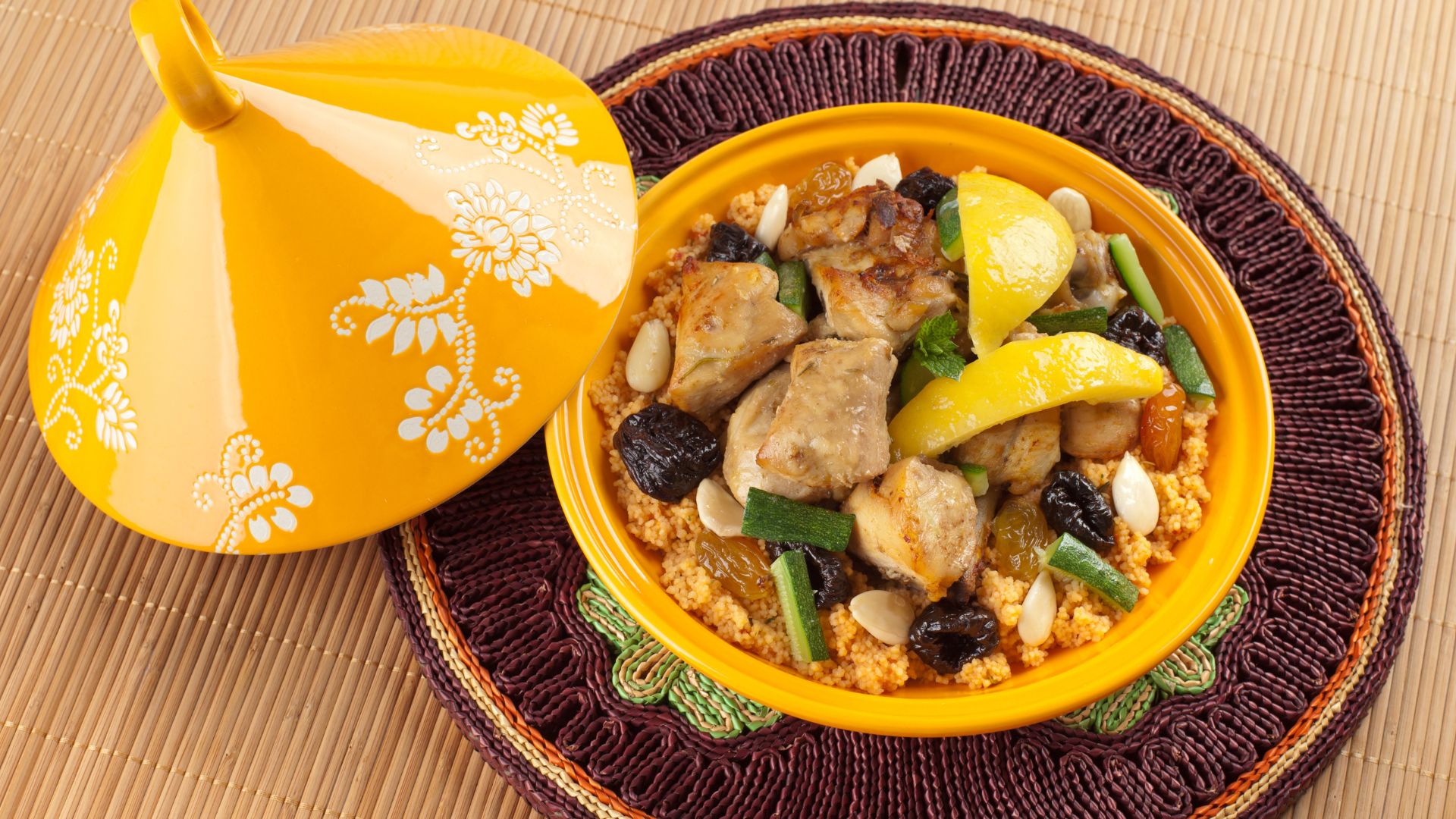The captivating country of Morocco in North Africa has a lot to offer visitors, including breathtaking coastlines, beautiful mountains, rich cultural traditions, and much more. But you must sample some of Morocco’s delicious cuisine while you’re there.
Morocco’s cuisine reveals a great deal about its past, present, and insatiable passion for flavorful meals crafted using local products. Therefore, on your next vacation to Morocco, don’t just eat the local cuisine; bring home some of its aromatic spices as well.
Here is a list of the top 10 Moroccan foods that you really must try during your vacation to Morocco if you’re not sure which cuisines to try first.
Top 10 Moroccan Food
1. Tagine: A Moroccan Culinary Masterpiece
In addition to being a staple of Moroccan cuisine, tagine plays a big role in the rich culinary history of the nation. It makes sense that the clay pot that was historically used to prepare this specialty gave it its name. Its conical lid served as a vent for condensation, which raised the flavors to the top and made them dense and delicious.
Typically, lamb or chicken chunks marinated in a mixture of spices, such as cumin, coriander, cinnamon, and saffron, are found in a traditional tagine. To achieve the ideal flavor balance, it is then slow-cooked with a blend of preserved lemons, olives, dried fruits like apricots or dates, and a small amount of honey or sugar. With crusty Moroccan bread, the outcome is a fragrant, soft, and somewhat sweet stew.
Sharing the first bite of the dinner with the entire family while seated around a table is a custom. Even though this practice is vanishing due to modern times, many people continue to follow it, particularly during holidays or other festive occasions.
2. Couscous: A Top Food in Morocco
Often referred to be Morocco’s national dish, couscous is a versatile and adored staple that embodies the best of the nation’s cuisine. This is one of the most well-known Moroccan recipes from long ago; it is a little semolina wheat granule that has gained popularity all over the world!
Steaming coarsely milled wheat semolina produces delicate, fluffy grains that are available in a range of flavors for making couscous. Usually, it is served with a flavorful stew consisting of lamb, poultry, vegetables, and aromatic spices like saffron, cumin, and coriander.
The stew’s seasoned liquids are absorbed by the couscous, resulting in a flavorful combination of texture and spices. After that, chickpeas, raisins, and a drizzle of broth are added as garnish, tantalizing the palate with the first bite.
Although you can sample wonderful Moroccan cuisine anywhere in the globe, only Moroccans can prepare and serve truly delicious couscous dishes. So don’t hesitate and reserve your Morocco trip packages right now!
3. Loubia: Moroccan Comfort in a Bowl
Morocco’s traditional cuisine, loubia, offers a soothing flavor to gourmets worldwide who are looking for lost but inventive cooking recipes.
Its simple ingredients and spices can easily become a culinary marvel if cooked well for hours.
The main ingredient in loubia is white beans, which are perfectly cooked when combined with paprika, cumin, and garlic. Although vegetarian versions are also widely consumed, the dish typically contains tiny bits of lamb or beef.
Tomatoes, onions, and a little olive oil add even more flavor to the dish, making it into a hearty stew. For a full dinner, loubia is usually served with couscous or crusty Moroccan bread. This combination is available in nearly all Middle Eastern restaurants worldwide, however it is particularly well-liked in nations like Algeria, Tunisia, and Libya.
In Moroccan tradition, loubia has a special place and is frequently consumed at celebrations and family get-togethers. This delicious food genuinely captures the spirit of Moroccan hospitality, and its simplicity and heartiness make it a symbol of warmth and community.
Next Article: Delicious Discoveries: Exploring the Top 10 Luxembourg Cuisines
4. Pastilla: A Moroccan Delicacy with a Touch of Sweetness
Pastilla, sometimes referred to as Bastilla or B’stilla, is a dish that is widely consumed in Morrica that is made by fusing delicious and sweet flavors.
Pastilla, one of the most well-liked Moroccan street delicacies, represents the harmony and balance inherent in Moroccan customs. The secret to a great pastilla is its rich filling, which is traditionally made with shredded pigeon meat. Currently, though, the original meat fillings have been substituted with variants made with chicken and seafood.
The meat is then cooked with a variety of fragrant and rich exotic spices, including ginger, coriander, cinnamon, and saffron. But the distinctive pastry shell of Pastilla is what really makes it stand out!
Yes, the delicious filling is encased in layers of thin, delicate phyllo dough, which is then cooked till golden and crispy. It is then generously coated with cinnamon and powdered sugar, which gives the Moroccan meal a sweet contrast.
So, be sure to sample this delicious pastry meal if you ever travel to Morocco or any other country in Africa. It has a realistic taste and comes in a range of flavors.
5. Harira: The Nourishing Moroccan Elixir
The popular Moroccan soup harira is deeply ingrained in Moroccan culture. When breaking fast during the holy month of Ramadan, this tasty dish is usually savored. Nonetheless, the majority of individuals sample its delicious flavors and nutritious nutrients without waiting for a celebration or special occasion.
Although you may always experiment and add more spice to the soup, this is how Moroccans typically make harira.
To get the desired thick texture, the standard method of producing broth was first followed by the addition of tomatoes, lentils, and chickpeas. Fragrant spices like coriander, ginger, and cinnamon are also added to enhance the flavor.
The use of fresh herbs, especially parsley and cilantro, which give the soup a bright, fragrant depth, is what really sets Harira apart from other Moroccan recipes.
Before serving, a quick squeeze of lemon juice enhances the flavor of the soup.
Ask for vegetarian harira specifically if you’re a vegetarian because it typically includes meat, like lamb or beef, which adds another level of flavor and richness.
In Morocco, harira is more than simply a soup—it’s a representation of solidarity and community. During Ramadan, families and friends frequently get together to enjoy a bowl of harira, strengthening ties and customs. Its calming and nourishing properties give the body and the soul nourishment.
6. M’semen: The Moroccan Pastry Delight
M’semen, sometimes called Rghaif or M’semen, is a delicious Moroccan pastry that blends layers of flakiness with a lovely combination of flavors. This popular breakfast or snack demonstrates the creativity of Moroccan cooking.
A dough consisting of basic components such as all-purpose flour, semolina, salt, water, and a small amount of vegetable oil is used to prepare M’semen. Next, the dough is divided into small balls, which are flattened and repeatedly folded inside out to form layers.
A blend of butter or oil and traditional Moroccan spices, such as paprika and cumin, is frequently brushed in between the layers while folding, giving the pastry a fluffy texture and deep flavor. The dough is made and then pan-fried till golden brown, giving it a crispy outside and a soft, fluffy inside.
M’semen is a multipurpose dish that has several ways to be consumed. It’s frequently eaten for breakfast or as a snack with cheese, honey, or jam. It’s also a well-liked side dish for delicious meals like tagine or harira, where it creates a wonderful contrast of flavors and textures.
7. Tanjia: The Slow-cooked Moroccan Delight
Tanjia is one of the special Moroccan meals and is often referred to as Marrakech’s street food gem. It encapsulates the flavors of the historic city and the concept of slow cooking.
Tanjia starts by choosing a particular clay pot bearing the same name. Typically, the dish consists of marinated lean beef or lamb chunks with a tantalizing mixture of spices such paprika, coriander, cumin, and saffron.
The most distinctive aspect of Tanjia is the use of garlic, olive oil, and preserved lemons, which give the meat a zesty, lemony flavor. After that, the meal is covered and cooked slowly for hours in a traditional wood-fired oven, enabling the meat to soften and the flavors to mingle. The end product is a flavorful dish that perfectly captures the spirit of Moroccan cooking.
In Marrakech, tajia has cultural value, especially for the males who used to congregate at the neighborhood’s hammams (open-air baths). The food was made at home and brought to the hammam to be cooked slowly while the men unwinded and breathed in the steam.
8. Matbucha – The Jewish Essence
A delicious Moroccan meal called matbucha has won over people’s hearts and palates all around the world. The meal is praised for its brilliant colors and well-balanced flavor combination. However, as many Moroccan Jews live in Israel, it is also served as an appetizer there. There, matbucha is added to salads, sandwiches, and grilled dishes.
Matbucha’s uniqueness comes from its components, which include ripe tomatoes, bell peppers, garlic, olive oil, and a variety of spices like chilli, paprika, and cumin. It’s a flexible complement to any dish because these components are chopped, cooked, and stewed together to provide a tantalizing burst of flavors. You can eat matbucha as a side dish, spread, or dip.
Because of the fresh ingredients and spices that are high in antioxidants, this dish also has health benefits. Maybe this explains why people still like it even when it’s included in bigger meals. Thus, on your next visit to the nation, be sure to sample the delicious Morrocan Matbucha.
9. B’ssara – Tasty but Nutritious Soup
A classic of Moroccan cooking, b’ssara is a flavorful soup that is well-known for being filling and nourishing.
Dried split fava beans, garlic, olive oil, cumin, and paprika are the main ingredients of B’ssara. After being soaked for the entire night, the fava beans are boiled till soft. They are mixed with paprika, cumin, garlic, and olive oil to make a creamy soup.
The end product is a fragrant, velvety soup that is customarily topped with wedges of lemon, fresh cilantro, and more cumin.
Fava beans are a great source of protein, fiber, and other vitamins, making B’ssara a tasty and healthful dish. It’s a filling dish with a lengthy history that’s typically eaten for breakfast or as a substantial appetizer.
B’ssara, with its unusual flavors and creamy texture, is a unique addition to the global culinary scene that highlights the attractiveness of Moroccan cuisine.
10. Chebakia – A Chewy, Crunchy Moroccan Treat
Chebakia is a delicious pastry from Morocco that entices the senses with its blend of spices and sweetness. This unusual confection is not only tasty but also aesthetically pleasing due to its flower-like form.
Sesame seeds, flour, honey, orange blossom water, rosewater, anise, and a mixture of spices like cinnamon and sesame seeds are the main components of Chebakia. But some also enjoy experimenting with the basic recipe, adding extras like sauces and vegetables.
Disclaimer
All the information given in this blog is for your information only and is not used for commercial purposes. Although we do not ensure the accuracy and completeness of this information. We make every possible effort to do so, but there may still be some errors in it. We Will not be held liable in any way for possible damages arising from the use of the article.




